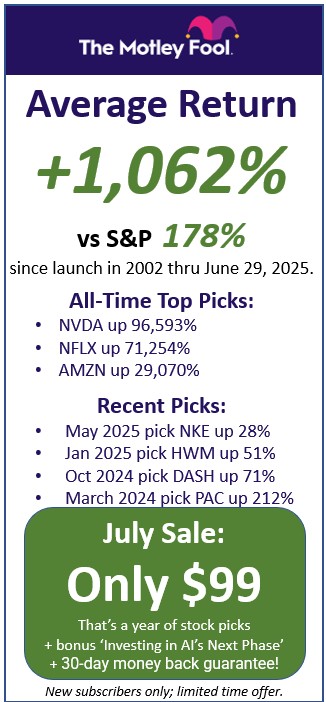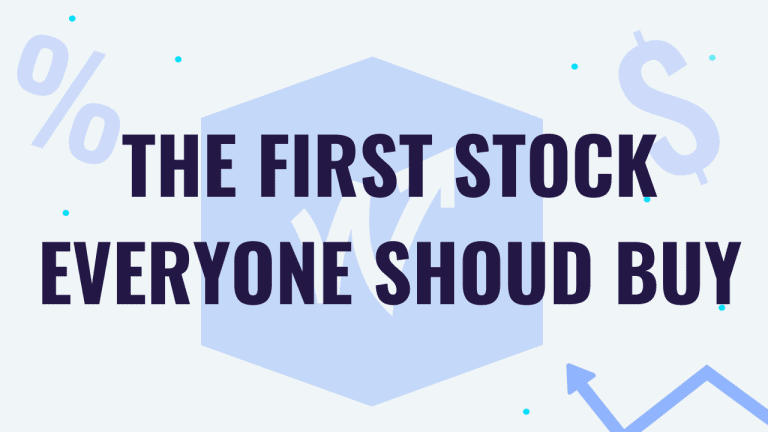No, this isn’t clickbait. We truly believe this type of stock is the first stock everyone should buy, and hold as the base of their portfolio. You’re about to be let in on a tried and true investing secret, so keep reading!
First Stock: The Secret
One of the most daunting tasks for new investors is making their first investment. There are thousands of companies and funds to invest in. I am going to let you in on a little secret… the type of stock that historically outperforms most stocks in the stock market…
The secret stock to kickstart your investment portfolio is an S&P 500 ETF. It is a lot for beginners to learn everything about the individual stocks on the market, so why not just “buy the market”? With ETFs, you can buy a given group of stocks in the stock market, all packed into one fund that trades just like a single stock!
So why is “buying the market” better than purchasing individual stocks? There is one glaring point that supersedes purchasing individual stocks… history! The most popular index is the S&P 500, and for the 94 years it has existed, the S&P 500 has delivered an average return of about 10% year over year. While the average investor in the market delivers returns of 1%.
What is an ETF?
Alright now, let’s start by explaining what an ETF is…
First and foremost, ETF stands for an exchange-traded fund, which is a type of security that includes a combination of other securities. So basically it is a stock that takes a number of other stocks and rolls it all up into one stock to be traded. The best example of this is the S&P 500. The S&P 500 is the largest 500 companies publicly traded in the U.S. So when you buy the S&P 500 the performance of the ETF is based on all 500 companies in the ETF. So depending on how companies like Apple, Johnson & Johnson, American Airlines, AT&T, or even Domino’s Pizza perform an ETF will take the net or average performance of all these companies.
First Stock: The Perks
One of the biggest perks of an ETF is its natural diversification. Diversification is essential as an investor because it mitigates the risk of your entire investment portfolio. To have a diversified portfolio you need to include companies that have different reactions to economic events, and market events. This is known as systematic risk and unsystematic risk.
If you were holding just one stock in the S&P 500 and that company had a terrible week, you’d lose quite a bit in your portfolio. But when you have a partial stake in all 500 companies in the S&P 500, the poor performance of one stock can be offset by the good performance of other stocks!
Let’s use a real-world situation.
The United States decided they are going to add a tax for all companies who manufacture goods outside the U.S. If your portfolio includes Apple, Nike & Walmart. Then your entire portfolio will see a sharp decline, but if you have a diversified portfolio you can minimize the negative impact of the tax implications. So if your portfolio includes Apple, Casper Mattress, & Boeing Co. Then you will not experience the same decline as the 1st portfolio. So overall it is important to create a portfolio that is exposed to different risks in the market.
Another benefit of using an ETF is the ease of Dollar-Cost Averaging. Dollar-Cost Averaging is an investment strategy to avoid volatility in the market. To effectively implement this strategy you continuously invest a set amount of money on a regular basis. For example, if Sue gets paid $1,000 every week, to Dollar-cost Average she should take 10% every week and invest it in her portfolio. This way your investment is protected against abrupt changes in the market.
If you invested a lump sum of money once a year, the market could be high and you could lose a lot of money if it declined shortly after. Also, if you use dollar-cost averaging then you can avoid poorly timing the market. Overall, when you use ETFs, you do not have to select or divided up your periodic investment, you can simply invest them into your selected ETF and your investment is already equally diversified.
The Best ETFs
So now that you understand what an ETF is and why they can be so beneficial it is time to select your ETF and start investing. The most popular ETF is the S&P 500; three great S&P 500 ETFs are iShares Core S&P 500 ETF (IVV), Vanguard S&P 500 ETF (VOO), and SPDR S&P 500 ETF Trust (SPY).
This is the most traditional type of ETF but you can purchase endless amounts of other types of ETFs. ETFs can be centered around companies in the tech industry, or in the auto industry or even the banking industry and many more. Naturally, the S&P 500 is the most diversified ETF, but if you are interested in specific industries you could invest in those as well. One of my favorite ETFs recently is Microsectors FANG+ ETF, the ticker symbol is FNGU. This ETF includes FAANG stocks, FAANG stands for Facebook, Amazon, Apple, Netflix, Google, as well as Alibaba, Baidu, NVIDIA, Tesla, and Twitter. This is a security that is specifically tailored to high growth technology stocks. So this ETF alone lacks diversification but has been performing very well over the past year.
First Stock: What is Next?
So now that you are in the on the secret, it is about time you kickstart your investment portfolio, with the first stock everyone should buy…Go find your favorite ETF and get started!
As always I am so glad you tuned in today to refine your investment skills. When you take the time and effort to build the foundation of your investment skills, you will have the fundamentals to succeed in the market. Each step will benefit your portfolio and help deliver high returns.
Our team at Wall Street Survivor will continue to be here to deliver content to help our investors; so continue to check in on the blog to learn about more skills, or check our the Wall Street Survivor Youtube channel, for videos on investing. There you will find a 10 part survivor 101 investing series to develop your fundamental investment skills. Now that you have at least one stock you can invest in, it is time to get started!
FIRST STEPS TO FINANCIAL SUCCESS:
At WallStreetSurvivor, we love with the stock market and we are obsessed with finding the best deals to help us all make more money. Here is our list of the BEST STOCK SERVICES to help you get start investing correctly:
1 - Get Up To $1,000 in FREE Stock with Robinhood! The fastest growing brokerage, Robinhood, just hit 10,000,000 accounts. Why? Because they DON'T charge commission AND they are giving away up to $1,000 in free stock when you open an account. CLICK HERE to learn more about Robinhood.
2 - Not Sure What Stocks to Buy? Get the BEST Stocks Picks! We subscribe to dozens of stock newsletters, and there is one that has outperformed all the rest for the last 5 years. This one service has an amazing average return of 74.63% on ALL of their stock picks the last 3 years. Their recent winners have been stocks like Shopify (SHOP) up 866%, Match Group (MTCH) up 549%, Paycom (PAYC) up 235%, and many others that have doubled in the last 3 years.
CLICK the image below go see their latest offer...

3 - Don't Pay Commission! Open a Real Brokerage Account and Trade Commission-Free. Here's the GREAT NEWS--the brokerage industry is very competitive right now and some brokers are offering FREE COMMISSIONS and other incentives to acquire new accounts. CLICK HERE to get commission-free trades. Or CLICK HERE to get a review of the Best Online Stock Brokers.
4 - Get the Best Stock Picking Newsletter of 2020 We subscribe to dozens of stock newsletters. Some of these newsletters are longer term investing, some are short term, and some are penny stocks. Find the best newsletter for your interests. So which stock newsletters are the best? Visit our review of the best stock newsletters.
5 - Is the Motley Fool a Good Source of Stock Picks? The Motley Fool is probably the best know stock newsletter service. Is it worth it? Read our full Motley Fool Review
